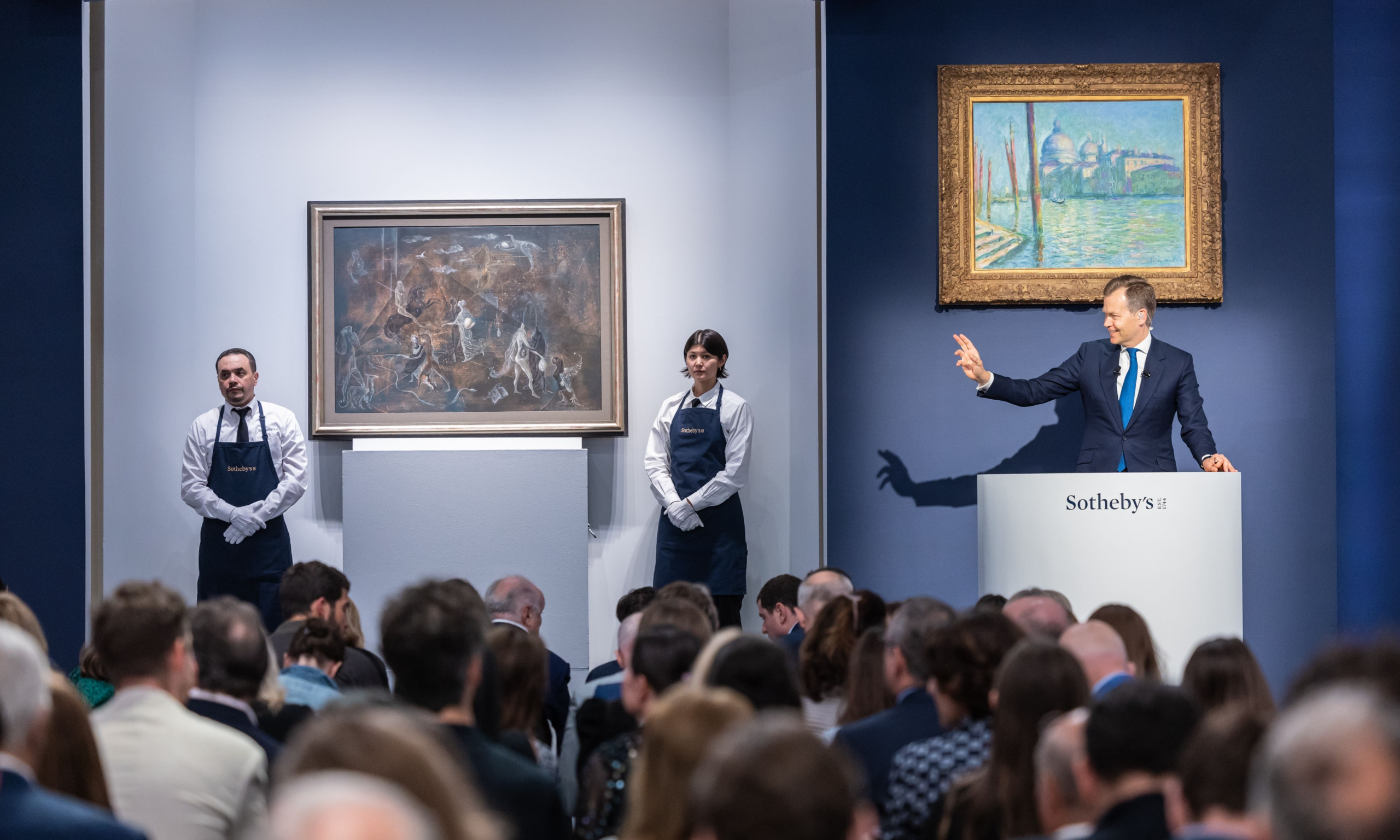Auctioneer Oliver Barker commands the sales floor at Sotheby's Modern Evening Sale. on 17 May. Courtesy Sotheby's
There are several reasons why aficionados would choose to tune in to an evening sale, whether or not they are among the monied-few who can hang masterworks on their walls. There is, of course, the voyeuristic pleasure of watching the wealthy buy beautiful things that most people can only covet. There are the bidding wars, some of which come at a rapid staccato from experts who act as proxies for mysterious collectors, though that is often the exception rather than the rule. Then there is the auctioneer, in Tuesday night's case, the inimitable Oliver Barker, the auction world's Mercutio. He is not the star of the show. But often he is the life of the party.
Barker played his role to perfection Tuesday night (May 17) in New York City during Sotheby’s evening sale of Modern art. The 61-lot affair moved along swiftly, a pleasure during an art week so stuffed with fairs, auctions and events that it is richer than foie gras. The sale featured much of what brings bidders and viewers to the table, though because of the sheer volume of lots some of the works felt like after-thoughts in an auction that—due perhaps in part to the recent tendency of specialists to mix eras and movements in more nonlinear fashion—at times felt both forced and too loosely thrown together.
Buyers may have felt the same: seven of the works failed to sell amid lackluster bidding, including Arshile Gorky’s Untitled (from the Fireplace in Virginia series) (1946, est $1.4m-$1.8m), Tamara de Lempicka’s Femme à la robe jaune (1929, est $5m-$7m) and Gustave Caillebotte’s charming glimpse into French estate life Le Jardin fleuriste, Yerres (1877, est $3.5m-$5m), and three works were withdrawn from the sale, a sign that perhaps there was not enough interest among the collector-class.
Pablo Picasso, Femme nue couchée Courtesy Sotheby's
Still, there were significant sales, despite the fact that the Modern sale was missing the pizazz that surrounded the previous night’s Macklowe redux, which brought in a total hammer price of $208.7m across 30 lots. Combined with the formidable $676.1m (with fees) from the first Macklowe sale in November that comes to a jaw-dropping $922.2m (with fees). To be fair, that is a hard act to follow, and Tuesday night's auction deserves attention for bringing in $408.5m (with fees), the third highest total for any sale at Sotheby’s.
The top lot of the sale was Pablo Picasso’s 1932 canvas Femme nue couchée, which hammered at $58.5m ($67.5m with fees) to a bidder on the sales floor. Like many of the lots, bidding was brisk but short. Barker opened the proceedings at $55m. Two minutes and a handful of bids later the picture was sold.
Paul Gauguin, Tahiti, Scene de Riviere Courtesy Sotheby's
That’s not to say the atmosphere never became heated. The eighth lot, Tahiti, scène de rivière by Paul Gauguin, one of the works on offer from the collection of Paul Yeou Chichong that was executed shortly after the artist arrived in Tahiti was bid on aggressively by at least four experts on the phone banks and ultimately went to worldwide head of sales and Sotheby’s chairman Brooke Lampley for $7.5m ($8.9m with fees). A client bidding with Lampley clinched the sale's second-biggest lot, Claude Monet’s Le Grand Canal et Santa Maria della Salute (1908, est around $50m), which Barker described as the pinnacle of a series of works that the artist made during his only trip to Venice and which was appearing at auction for the first time.The limpid, delicate scene hammered at $49m ($56m with fees) with Lampley’s bidder winning out over other phone bidders and a bidder in the room.
Willem de Kooning, Leaves in Weehawken Courtesy Sotheby's
Willem De Kooning’s Leaves in Weehawken (1958) arguably sparked the most exciting exchange of the evening. Bids for the canvas bounced between a bidder on the sales floor and two Sotheby’s experts in phone banks on opposite sides of the room like hot oil spattering out of a sauté pan. Eventually the in-person bidder bowed out while Simon Shaw, vice chairman of the auction house’s fine arts division, and Bame Fierro March of the contemporary art division stared daggers at one another across the room, handsets pressed firmly to their ears and their hands covering their mouths so as not to give anything away. The picture hammered for $8.5m ($10m with fees) against an estimate of $3m-$5m, to Fierro March's bidder.
The true highlight, as always, was Barker, who took several sips of water throughout the sale to lubricate a set of vocal cords that, if installed in a different model, would likely betray audible signs of wear and tear. “Are the Mets winning tonight,” Barker said after an awkward moment in which the hammer came down on Paul Signac’s deeply colourful Le Cabanon (Saint-Tropez) (1904), which “sold” for $2.6m, only for bidding to be reopened after a delayed bid from the phone banks in Hong Kong.
Paul Signac, Le Cabanon (Saint-Tropez) Courtesy Sotheby's
“I’m terribly sorry, it’s far too late….do we have a bid? We are going to start this one again…Jen, if you can have your bidder ready and focused, thank you,” Barker said to Jen Hua, deputy chairman of Sotheby’s Asia. A few moments later Hua’s bidder took the work for $100,000 more than the previous winner. “Well worth the wait,” Barker said before moving on.
New York's major spring evening sales continue with Phillips's auction of 20th century and contemporary art on 18 May and conclude back at Sotehby's on 19 May with a double-header: a contemporary art auction preceded by the ultra-contemporary and women-dominated "The Now" sale.

